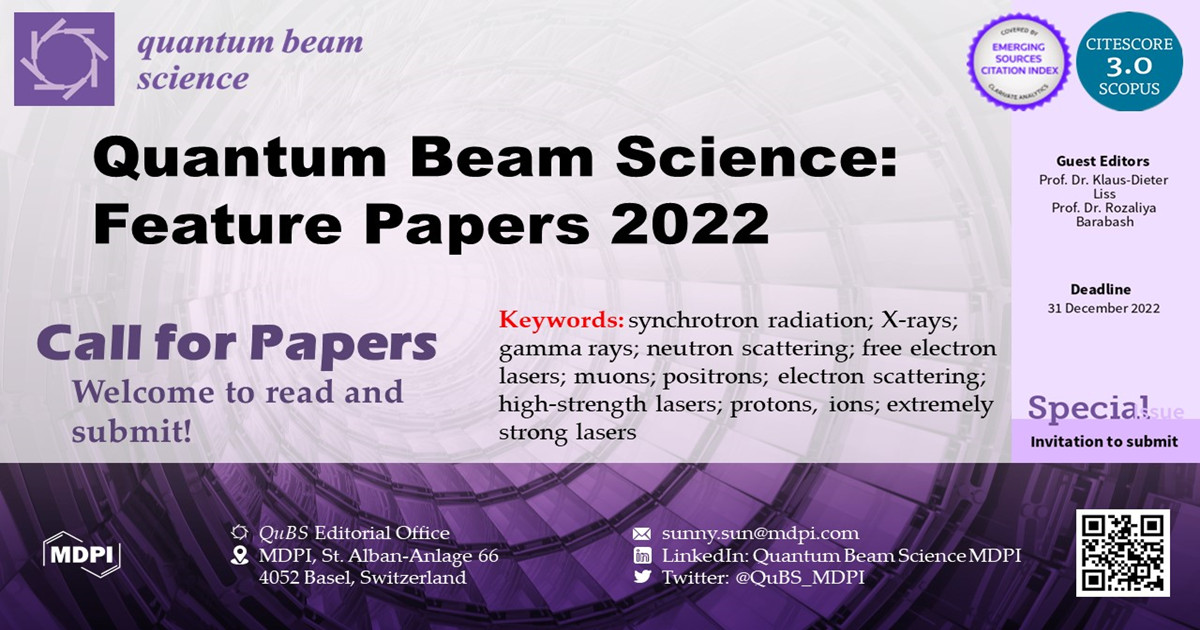Quantum Beam Science: Feature Papers 2022
A special issue of Quantum Beam Science (ISSN 2412-382X).
Deadline for manuscript submissions: closed (31 December 2022) | Viewed by 17620

Special Issue Editors
Interests: X-ray free electron; in-situ investigations; extreme conditions
Special Issues, Collections and Topics in MDPI journals
Interests: neutron diffraction; microscopy; X-ray
Special Issues, Collections and Topics in MDPI journals
Special Issue Information
Dear Colleagues,
As Editor-in-Chief of the journal Quantum Beam Science (ISSN 2412-382X), it is my pleasure to announce the launch of a new Special Issue on “Quantum Beam Science: Feature Papers 2022”. QuBS is an international, open-access journal publishing reviews and original research focusing on the application of quantum beams for the study and characterization of materials in their widest sense, as well as developments of quantum beam sources, instrumentation and facilities. In this Special Issue, we will publish outstanding contributions in the main fields covered by the journal, which will make a great contribution to the community. The entire issue will be published in book format after it is closed.
Quantum beams include synchrotron radiation, X-rays, gamma rays, neutron beams, electrons, lasers, muons, positrons, ions, or extremely strong lasers, while materials can be crystalline, amorphous, magnetic, metallic, ceramic, biologic, hard or soft matter, warm dense matter, functional, structural and so on. Quantum beam science covers a broad range of disciplines including, but not limited to, solid-state physics, chemistry, crystallography, materials science, biology, geology, earth and planetary materials, and engineering. Examples of investigations include phase transformations in alloy development, modulated structures in spintronic systems, crystalline order and disorder, stresses in engineering specimens, changes in amorphous structure, excitations in functional materials, the interior of stars, electrochemistry in ion battery systems, imaging in life sciences, and the propagation of dislocations in crystals.
Submissions are encouraged to present multiple quantum beams for complementary studies, such as neutron and synchrotron radiation, or muons and neutrons. Instrumental publications may cover large user facilities, novel developments, sources, spectrometers, diffractometers, functionality, physical- and optical-based background, scattering and interaction theories with respect to the application, and the fundamentals of the probe.
Submitted papers will be evaluated by the Editors first. Please note that all papers will be subjected to a thorough and rigorous peer review.
Prof. Dr. Klaus-Dieter Liss
Prof. Dr. Rozaliya Barabash
Guest Editors
Manuscript Submission Information
Manuscripts should be submitted online at www.mdpi.com by registering and logging in to this website. Once you are registered, click here to go to the submission form. Manuscripts can be submitted until the deadline. All submissions that pass pre-check are peer-reviewed. Accepted papers will be published continuously in the journal (as soon as accepted) and will be listed together on the special issue website. Research articles, review articles as well as short communications are invited. For planned papers, a title and short abstract (about 100 words) can be sent to the Editorial Office for announcement on this website.
Submitted manuscripts should not have been published previously, nor be under consideration for publication elsewhere (except conference proceedings papers). All manuscripts are thoroughly refereed through a single-blind peer-review process. A guide for authors and other relevant information for submission of manuscripts is available on the Instructions for Authors page. Quantum Beam Science is an international peer-reviewed open access quarterly journal published by MDPI.
Please visit the Instructions for Authors page before submitting a manuscript. The Article Processing Charge (APC) for publication in this open access journal is 1600 CHF (Swiss Francs). Submitted papers should be well formatted and use good English. Authors may use MDPI's English editing service prior to publication or during author revisions.
Keywords
- synchrotron radiation
- X-rays
- gamma rays
- neutron scattering
- free electron lasers
- muons
- positrons
- electron scattering
- high-strength lasers
- protons, ions
- extremely strong lasers






